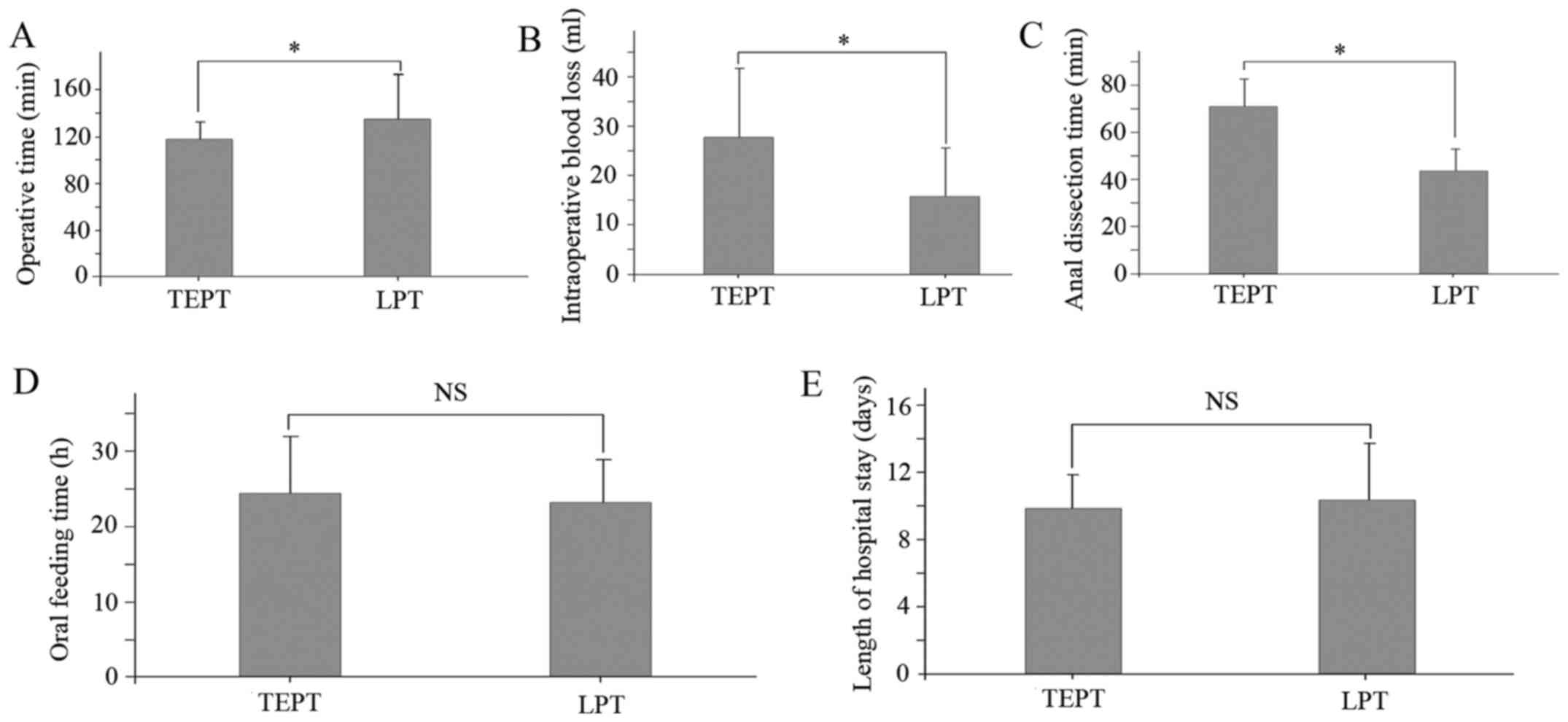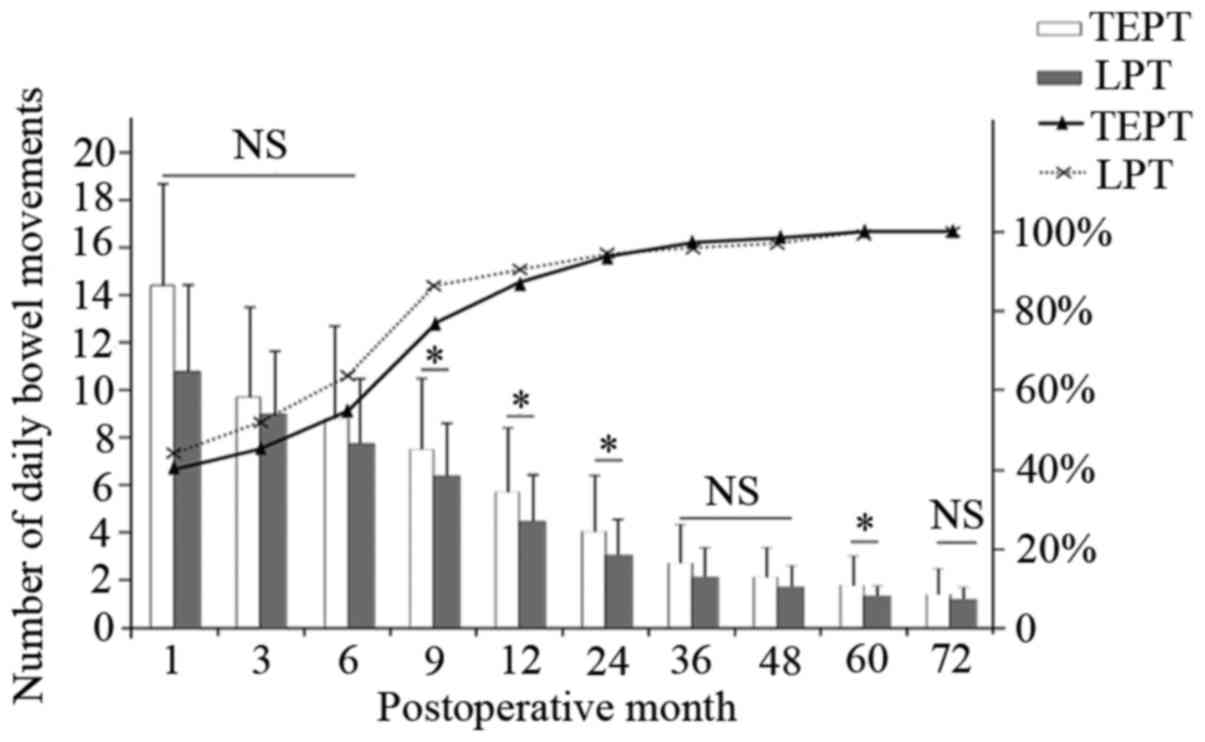|
1
|
Stensrud KJ, Emblem R and Bjonland K: Anal
endosonography and bowel function in patients undergoing different
types of endorectal pull-through procedures for Hirschsprung
disease. J Pediatr Surg. 50:1341–1346. 2015. View Article : Google Scholar : PubMed/NCBI
|
|
2
|
Zhang S, Li J, Wu Y, Hu Y, Duan C, Wang M
and Gai Z: Comparison of laparoscopic-assisted operations and
laparotomy operations for the treatment of hirschsprung disease:
evidence from a meta-analysis. Medicine (Baltimore). 94:e16322015.
View Article : Google Scholar : PubMed/NCBI
|
|
3
|
Tomuschat C, Zimmer J and Puri P:
Laparoscopic-assisted pull-through operation for Hirschsprung's
disease: A systematic review and meta-analysis. Pediatr Surg Int.
32:751–757. 2016. View Article : Google Scholar : PubMed/NCBI
|
|
4
|
Xiong X, Chen X, Wang G and Feng J: Long
term quality of life in patients with Hirschsprung's disease who
underwent heart-shaped anastomosis during childhood: A twenty-year
follow-up in China. J Pediatr Surg. 50:2044–2047. 2015. View Article : Google Scholar : PubMed/NCBI
|
|
5
|
Puri P: Hirschsprung's diseasePediatric
Surgery. Puri P and Höllwarth M: Springer; Berlin: pp. 275–288.
2005
|
|
6
|
Zhang JS, Li L, Hou WY, Liu SL, Diao M,
Zhang J, Ming AX and Cheng W: Transanal rectal mucosectomy and
partial internal anal sphincterectomy for Hirschsprung's disease. J
Pediatr Surg. 49:831–834. 2014. View Article : Google Scholar : PubMed/NCBI
|
|
7
|
Langer JC, Minkes RK, Mazziotti MV,
Skinner MA and Winthrop AL: Transanal one-stage Soave procedure for
infants with Hirschsprung's disease. J Pediatr surg. 34:148–151.
1999. View Article : Google Scholar : PubMed/NCBI
|
|
8
|
De La Torre L and Ortega A: Transanal
versus open endorectal pull-through for Hirschsprung's disease. J
Pediatr surg. 35:1630–1632. 2000. View Article : Google Scholar : PubMed/NCBI
|
|
9
|
Georgeson KE, Cohen RD, Hebra A, Jona JZ,
Powell DM, Rothenberg SS and Tagge EP: Primary
laparoscopic-assisted endorectal colon pull-through for
Hirschsprung's disease: A new gold standard. Ann Surg. 229:678–683.
1999. View Article : Google Scholar : PubMed/NCBI
|
|
10
|
Thomson D, Allin B, Long AM, Bradnock T,
Walker G and Knight M: Laparoscopic assistance for primary
transanal pull-through in Hirschsprung's disease: A systematic
review and meta-analysis. BMJ Open. 5:e0060632015. View Article : Google Scholar : PubMed/NCBI
|
|
11
|
Granström AL, Husberg B, Nordenskjöld A,
Svensson PJ and Wester T: Laparoscopic-assisted pull-through for
Hirschsprung's disease, a prospective repeated evaluation of
functional outcome. J Pediatr surg. 48:2536–2539. 2013. View Article : Google Scholar : PubMed/NCBI
|
|
12
|
Khazdouz M, Sezavar M, Imani B, Akhavan H,
Babapour A and Khademi G: Clinical outcome and bowel function after
surgical treatment in Hirschsprung's disease. Afr J Paediatr Surg.
12:143–147. 2015. View Article : Google Scholar : PubMed/NCBI
|
|
13
|
Zhang SC, Bai YZ, Wang W and Wang WL:
Clinical outcome in children after transanal 1-stage endorectall
pull-through operation for Hirschsprung's disease. J Pediatr Surg.
40:1307–1311. 2005. View Article : Google Scholar : PubMed/NCBI
|
|
14
|
Elhalaby EA, Teitelbaum DH, Coran AG and
Heidelberger KP: Enterocolitis associtated with Hirschsprung's
disease: A clinical histopathological correlative study. J Pediatr
Surg. 30:1023–1027. 1995. View Article : Google Scholar : PubMed/NCBI
|
|
15
|
El-Sawaf MI, Drongowski RA, Chamberlain
JN, Coran AG and Teitelbaum DH: Are the long-term results of the
transanal pull-through equal to those of the transabdominal
pull-through? A comparison of the 2 approaches for Hirschsprung's
disease. J Pediatr Surg. 42:41–47. 2007. View Article : Google Scholar : PubMed/NCBI
|
|
16
|
Dickie BH, Webb KM, Eradi B and Levitt MA:
The problematic Soave cuff in Hirschsprung disease: Manifestations
and treatment. J Pediatr Surg. 49:77–80. 2014. View Article : Google Scholar : PubMed/NCBI
|
|
17
|
Rouzrokh M, Jadali F, Gharib A,
Khaleghnejad-Tabari A, Tavassoli A and Mohajerzadeh L: Can we rely
on frozen sections of a rectal biopsy for one-stage trans-anal
pull-through operation in hirschsprung's disease? Iran J Pediatr.
21:72–76. 2011.PubMed/NCBI
|
|
18
|
Agrawal RK, Kakkar N, Vasishta RK, Kumari
V, Samujh R and Rao KL: Acetylcholinesterase histochemistry
(AChE)-A helpful technique in the diagnosis and in aiding the
operative procedures of Hirschsprung disease. Diagn Pathol.
10:2082015. View Article : Google Scholar : PubMed/NCBI
|
|
19
|
Podevin G, Lardy H, Azzis O, Branchereau
S, Petit T, Sfeir R, Weil D, Heloury Y and Fremond B: Technical
problems and complications of transanal pull-through for
Hirschsprung's disease. Eur J Pediatr Surg. 16:104–108. 2006.
View Article : Google Scholar : PubMed/NCBI
|
|
20
|
Ishihara M, Yamataka A, Kaneyama K, Koga
H, Kobayashi H, Lane GJ and Miyano T: Prospective analysis of
primary modified Georgeson's laparoscopy-assisted endorectal
pull-through for Hirschsprung's disease: Short-to mid-term results.
Pediatr Surg Int. 21:878–882. 2005. View Article : Google Scholar : PubMed/NCBI
|
|
21
|
Tang ST, Wang GB, Cao GQ, Wang Y, Mao YZ,
Li SW, Li S, Yang Y, Yang J and Yang L: 10 years of experience with
laparoscopic-assisted endorectal Soave pull-through procedure for
Hirschsprung's disease in China. J Laparoendosc Adv Surg Tech A.
22:280–284. 2012. View Article : Google Scholar : PubMed/NCBI
|
|
22
|
Aubdoollah TH, Li K, Zhang X, Li S, Yang
L, Lei HY, Dolo PR, Xiang XC, Cao GQ, Wang GB and Tang ST: Clinical
outcomes and ergonomics analysis of three laparoscopic techniques
for Hirschsprung's disease. World J Gastroenterol. 21:8903–8911.
2015. View Article : Google Scholar : PubMed/NCBI
|
|
23
|
Menezes M, Corbally M and Puri P:
Long-term results of bowel function after treatment for
Hirschsprung's disease: A 29-year review. Pediatr Surg Int.
22:987–990. 2006. View Article : Google Scholar : PubMed/NCBI
|
|
24
|
Huang Y, Zheng S and Xiao X: A follow-up
study on postoperative function after a transanal Soave 1-stage
endorectal pull-through procedure for Hirschsprung's disease. J
Pediatr Surg. 43:1691–1695. 2008. View Article : Google Scholar : PubMed/NCBI
|
|
25
|
Ishikawa N, Kubota A, Kawahara H, Hasegawa
T, Okuyama H, Uehara S and Mitani Y: Transanal mucosectomy for
endorectal pull-through in Hirschsprung's disease: Comparison of
abdominal, extraanal and transanal approaches. Pediatr Surg Int.
24:1127–1129. 2008. View Article : Google Scholar : PubMed/NCBI
|
|
26
|
Dahal GR, Wang JX and Guo LH: Long-term
outcome of children after single-stage transanal endorectal
pull-through for Hirschsprung's disease. World J Pediatr. 7:65–69.
2011. View Article : Google Scholar : PubMed/NCBI
|
|
27
|
Van de Ven TJ, Sloots CE, Wijnen MH,
Rassouli R, van Rooij I, Wijnen RM and de Blaauw I: Transanal
endorectal pull-through for classic segment Hirschsprung's disease:
With or without laparoscopic mobilization of the rectosigmoid? J
Pediatr Surg. 48:1914–1918. 2013. View Article : Google Scholar : PubMed/NCBI
|
|
28
|
Chen Y, Nah SA, Laksmi NK, Ong CC, Chua
JH, Jacobsen A and Low Y: Transanal endorectal pullthrough versus
transabdominal approach for Hirschsprung's disease: A systematic
review and meta-analysis. J Pediatr Surg. 48:642–651. 2013.
View Article : Google Scholar : PubMed/NCBI
|
|
29
|
Rescorla FJ, Morrison AM, Engles D, West
KW and Grosfeld JL: Hirschsprung's disease. Evaluation of mortality
and long-term function in 260 cases. Arch Surg. 127:934–942. 1992.
View Article : Google Scholar : PubMed/NCBI
|
|
30
|
Kim AC, Langer JC, Pastor AC, Zhang L,
Sloots CE, Hamilton NA, Neal MD, Craig BT, Tkach EK, Hackam DJ, et
al: Endorectal pull-through for Hirschsprung's disease-a
multicenter, long-term comparison of results: Transanal vs
transabdominal approach. J Pediatr Surg. 45:1213–1220. 2010.
View Article : Google Scholar : PubMed/NCBI
|
|
31
|
Miyano G, Koga H, Okawada M, Doi T,
Sueyoshi R, Nakamura H, Seo S, Ochi T, Yamada S, Imaizumi T, et al:
Rectal mucosal dissection commencing directly on the anorectal line
versus commencing above the dentate line in laparoscopy-assited
transanal pull-through for Hirschsprung's disease: prospective
medium-term follow-up. J Pediatr Surg. 50:2041–2043. 2015.
View Article : Google Scholar : PubMed/NCBI
|
|
32
|
Giuliani S, Betalli P, Narciso A, Grandi
F, Midrio P, Mognato G and Gamba P: Outcome cpmparison among
laparoscopic Duhamel, laparotomic Duhamel and transanal endorectal
pull-through: A single-center, 18-year experience. J Laparoendosc
Adv Surg Tech A. 21:859–863. 2011. View Article : Google Scholar : PubMed/NCBI
|
|
33
|
Yan Z, Poroyko V, Gu S, Zhang Z, Pan L,
Wang J, Bao N and Hong L: Characterization of the intestinal
microbiome of Hirschsprung's disease with and without
enterocolitis. Biochem Biophys Res Commun. 445:269–274. 2014.
View Article : Google Scholar : PubMed/NCBI
|
















